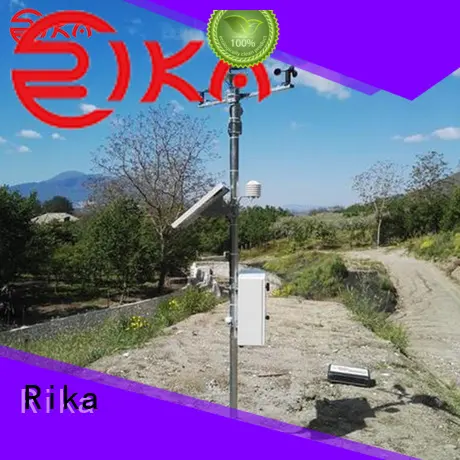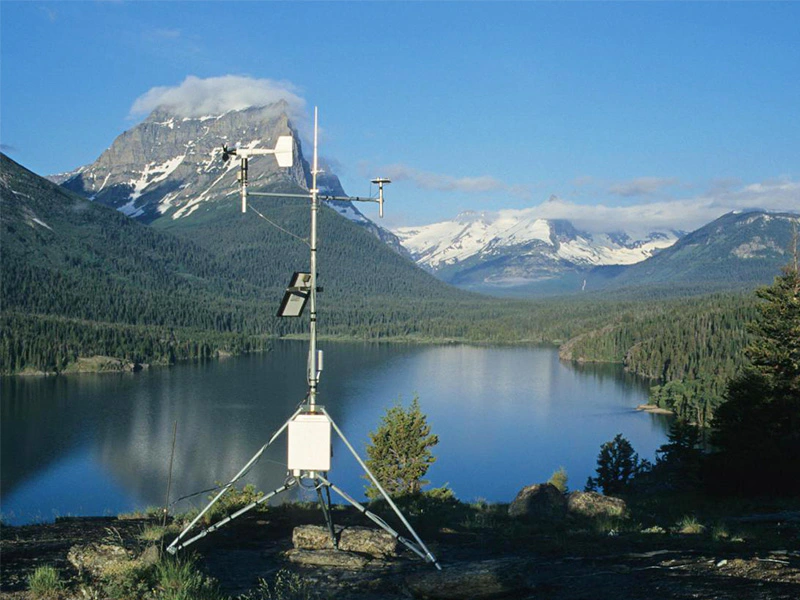Rika Sensor is a weather sensor manufacturer and environmental monitoring solution provider with 10+ years of industry experience.


Rika weather station factory for wind speed & direction detecting
- Rika Sensors provides excellent services for customers on the premise of meeting customer demand.
PRODUCT DESCRIPTION
RK900-01 Automatic Weather Station is used for atmospheric temperature, relative humidity, atmospheric pressure,wind speed & direction,solar radiation,light,rainfall,soil temperature and humidity parameters measurement.The station consists of various types of sensors, LCD screen, meteorological data collector, chassis, support and other parts.It can be widely used in meteorology, hydrology, agriculture, forestry, scientific research and other fields.
SPECIFICATIONS
Parts | Details | Note |
Data logger | Meteorological data collection, display, storage and communications | |
Sensors & cable | Wind speed sensor, wind direction sensor, atmospheric temperature, atmospheric humidity, atmospheric pressure, rainfall, solar radiation, soil temperature, soil moisture,etc. (Optional according to user's requirements) | |
Meteorological monitoring software | Use to real-time display, analysis and storage data on the PC | Attached |
Used to install the atmospheric temperature, atmospheric humidity and atmospheric pressure sensors | ||
Tripod & accessories | Height: 2.5m typ.,304SS or | |
Protective box | Used to install data logger,solar charge controller and battery, stainless steel or steel with coating | |
110VAC/220VAC adapter | Optional when using AC power supply | |
RS485 cable | 2m | |
RS485 converter | Signal Conversion for RS485 | |
U disk | Used for data storage | optional |
GPRS module | Used for wireless data transmission, need to match with the local mobile communication network | optional |
WIFI module | Used for wireless data transmission,need for wireless networking | optional |
Ethernet module | Used for wireless data transmission,need for cable network | optional |
LED screen | Size and display content can be customized | optional |
Solar power supply system | Include photovoltaic panels(30W), solar charge controller, 25AH battery(Can't be transported by air. Suggest users to bring their own) | optional |
Lightning protection device | Contain the lightning rod, connecting wires and grounding angle steel | optional |
Windbreak wire | Used for fixing 10m support rod | |
Base fixed steel cage | Used for fixing 10m support rod |
Note:10 m support is recommended for mountainous area or surrounding area with high buildings.
TYPICAL APPLICATION & TECHNICAL SPECIFICATION
General weather station:
Measure item | Measure range | Resolution | Accuracy |
Wind speed | 0-45m/s | 0.1m/s | ±(0.3±0.03V)m/s |
Wind direction | 0-360º | 1° | ±3° |
Atmospheric temperature | -40-+60℃ | 0.1℃ | ±0.5℃ |
Atmospheric humidity | 0-100%RH | 0.1%RH | ±3% |
Atmospheric pressure | 10-1100hPa | 0.1hpa | ±0.3hPa |
Rainfall | 0-8mm/min | 0.2mm | ±4% |
Solar radiation | 0-2000W/m2 | 1W/m2 | ±5% |
Photovoltaic power generation weather station:
Measure item | Measure range | Resolution | Accuracy |
Wind speed | 0-45m/s | 0.1m/s | ±(0.3±0.03V)m/s |
Wind direction | 0-360º | 1° | ±3° |
Atmospheric temperature | -40-+60℃ | 0.1℃ | ±0.5℃ |
Atmospheric humidity | 0-100%RH | 0.1%RH | ±3% |
Atmospheric pressure | 10-1100hPa | 0.1hpa | ±0.3hPa |
Photovoltaic panels temperature sensor | -50-+100℃ | 0.1℃ | ±0.5℃ |
Total solar radiation | 0-2000W/m2 | 1W/m2 | ±3% |
Rainfall(optional) | 0-8mm/min | 0.2mm | ±4% |
Hall current sensor(optional) | 0-500V | 1V | ±0.5% |
Hall voltage sensor(optional) | 0-150A | 0.1A | ±0.5% |
Agricultural weather station:
Measure item | Measure range | Resolution | Accuracy |
Wind speed | 0-45m/s | 0.1m/s | ±(0.3±0.03V)m/s |
Wind direction | 0-360° | 1° | ±3° |
Atmospheric temperature | -50-+100℃ | 0.1℃ | ±0.5℃ |
Atmospheric humidity | 0-100%RH | 0.1%RH | ±3% |
Atmospheric pressure | 10-1100hPa | 0.1hpa | ±0.3hPa |
Solar radiation | 0-2000W/m2 | 1W/m2 | ±5% |
PAR sensor | 0-2500μ*mol*m2*s | 1μ*mol*m2*s | ±1% |
Rainfall | 0-8mm/min | 0.2mm | ±4% |
Soil temperature | -50-+80℃ | 0.1℃ | ±0.5℃ |
Soil moisture | 0-100% | 1% | ±3% |
CO2(optional) | 0-5000ppm | 1ppm | ±3% |
Soil PH(optional) | 0-14PH | 0.1PH | ±0.1PH |
Soil salinity(optional) | 0-15000mg/L | 1mg/L | ±5% |
Soil EC(optional) | 0-20mS/cm | 0.1mS/cm | ±5% |
Greenhouse comprehensive monitoring station:
Measure item | Measure range | Resolution | Accuracy |
Atmospheric temperature | -50-+100℃ | 0.1℃ | ±0.5℃ |
Atmospheric humidity | 0-100%RH | 0.1%RH | ±3% |
Atmospheric pressure | 10-1100hPa | 0.1hpa | ±0.3hPa |
CO2 | 0-5000ppm | 1ppm | ±3% |
Illuminance | 0-200000lux | 1lux | ±7% |
Soil temperature | -50-+80℃ | 0.1℃ | ±0.5℃ |
Soil moisture | 0-100% | 1% | ±3% |
Solar radiation(optional) | 0-2000W/m2 | 1W/m2 | ±5% |
PAR sensor(optional) | 0-250μ*mol*m2*s | 1μ*mol*m2*s | ±1% |
Soil PH(optional) | 0-14PH | 0.1PH | ±0.1PH |
Soil salinity(optional) | 0-15000mg/L | 1mg/L | ±5% |
Soil EC(optional) | 0-20mS/cm | 0.01mS/cm | ±5% |
Scenic area weather station:
Measure item | Measure range | Resolution | Accuracy |
Wind speed | 0-45m/s | 0.1m/s | ±(0.3±0.03V)m/s |
Wind direction | 0-360º | 1° | ±3° |
Atmospheric temperature | -50-+100℃ | 0.1℃ | ±0.5℃ |
Atmospheric humidity | 0-100%RH | 0.1%RH | ±3% |
Atmospheric pressure | 10-1100hPa | 0.1hpa | ±0.3hPa |
Rainfall | 0-8mm/min | 0.2mm | ±4% |
Uv radiation | 0-200W/m2 | 1W/m2 | ±5% |
Ground temperature | -50-+80℃ | 0.1℃ | ±0.5℃ |
Notice:
1.The measurement items can be increased or deleted in the table;
2.Measured data is automatically recorded and stored for download analysis;
3.If there are other functional requirements, we can provide customized solutions.
PRODUCT DETAILS
PRODUCT APPLICATION
DATA LOGGER SPECIFICATION
Item | Details |
LCD | 192 * 64 |
Internal storage | 12M (If set to store every 1 hours can store data for more than 4 years; |
External storage | Use special U disk to store data (optional function) |
Data interface | RS232, RS485, USB |
Communication mode | Ethernet(add RS232 to ethernet converter); |
Communication protocol | MODBUS-RTU(Open communication protocol, the user can convenient for secondary development) |
Supply | 12VDC, AC110V, AC220V, solar power supply system optional |
Record interval | 1min-240min adjustable |
Input parameter | 16 max. |
Power consumption | <2W |
Operating temperature | -40-+75℃ |
Weight(unpacked) | 3.2kg |
Dimension | 310*218*120mm |
Shell material | RK600-02:ABS(Installed in protective box,protective box is optional) |
Meteorological monitoring software | Use to display, analysis and storage data on the PC |
Guidelines for the Selection of Data logger:
If solar power supply is needed, RK600-02 is recommended, data logger, solar controller and battery can be installed in protective box.
Key Instruction:
KEY | Function | KEY | Function |
↑ | Up | + | Value increases |
↓ | Down | - | Value decreases |
← | Left / Shift to the previous interface | OK | Enter the menu |
→ | Right / Shift to the after interface | Esc | Exit menu |
Parameter Settings:
Item | Function |
Version | View data logger software version number |
Time settings | Set data logger system clock |
Other settings | Set electronic compass (optional function) |
Communication settings | Set data logger address(0-255,RS232/RS485 communication) |
Reset | After reset all parameters must be reset and clear the history data |
Time interval | Set the data storage time interval(1-240min) |
Language settings | Chinese/English |
External storage | External storage type(U disk/No, If no external storage, set to no) |
INTERFACE DESCRIPTION & SYSTEM CONNECTION DIAGRAM
E-Mail: info@rikasensor.com
After-sales Service: support@rikasensor.com
Mobile: +86 13367318895
WhatsApp |Wechat
+86 13367318895
Address: Room 304, Building 10, Phase 4, No. 188, Huanbao Middle Road, Tongsheng Street, Yuhua District, Changsha, China.

